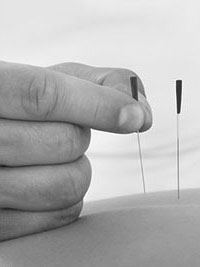Acupuncture
Acupuncture is a branch of Chinese medicine that has been used for millennia to help treat virtually every disease and illness. By inserting fine stainless steel needles into key points in the muscles and along the channels of qi, or life force energy, the therapist regulates the flow of qi. In this way the body’s vital energies are stimulated to promote self healing capacities. When the needles are stimulated, patients may feel some cramping, tingling or electric sensation either around the needles or along the associated energy pathway. In many cases, clients are unaware that needles have been inserted. The use of acupuncture as a medical intervention in North America is expanding and most extended medical plans in BC include some coverage.
Japanese Acupuncture
Japanese acupuncture shares the same principles and understanding of harmonious health originally described in Chinese classical texts introduced in Japan in the 6th Century.
The practice of Japanese acupuncture is mostly known today for its sensitive approach to meridian balancing, a therapeutic process in which the therapist assesses treatment points through skillful palpation and the use of gentle stimulation techniques. Another characteristic of the Japanese approach is the use of thinner needles and shallower, more comfortable insertions. In some cases, the needle is not inserted at all. This approach makes acupuncture even more suited to children and sensitive or first time patients.
Benefits
Some of the many conditions that acupuncture have been shown to help include:
- Post operative pain and rehabilitation
- Post chemotherapy nausea
- Addictions
- Stroke rehabilitation
- Headaches
- Menstrual cramps
- Fertility issues
- Tennis elbow
- Lower back pain
- Sciatica
- Osteoarthritis
- Myofascial pain
- Carpal tunnel syndrome
- Asthma
- Anxiety
- Stress related disorders
FAQ
What does it feel like? Is it painful?
Acupuncture treatments are usually comfortable and relaxing. Most feel no pain or very little pain upon insertion of the needles. You might experience a mild ache or warmth around the needle site.
I’m afraid of needles. Can I still receive treatments?
Yes. Some styles, like Japanese acupuncture, use very shallow insertions or simply make contact with the skin. The needles are very fine and are hardly noticeable once they are in place.
What can acupuncture treat?
Acupuncture is considered to be beneficial for a range of illnesses and symptoms and is safe and suitable for everyone from children to seniors. See our Acupuncture page (link here)for a short list of conditions it can benefit.
Are there side effects?
Acupuncture has almost no adverse side effects. The York Acupuncture Safety Study, a 2001 prospective study of 34,407 treatments, found no serious side effects and 43 cases of minor adverse effects.
http://www.acupuncturetoday.com/archives2001/nov/11safety.html
How many treatments will I need?
That depends on your condition. You should feel benefits after the first or second treatment but chronic conditions typically take longer to improve. Initially, weekly treatments are advised, followed by a period of bi-weekly or monthly maintenance treatments in chronic cases. Many clients come every few weeks for preventative treatments once their health has stabilized.
What should I do before and after a treatment?
Avoid having a large meal for at least an hour before treatment, and wear loose fitting clothing, so that the acupuncture points can be accessed. After your treatment you are likely to feel relaxed and calm, or drowsy. Drink extra water and avoid strenuous activities, alcohol, nicotine or caffeine for a few hours.
Is acupuncture covered by MSP and extended medical plans?
MSP covers a portion of the treatment cost for those on Premium Assistance, and most extended medical plans cover acupuncture. Contact your insurance provider for details.
Acupuncture Practitioners

Ted Thomas
RST, R.Ac
Book with Ted

